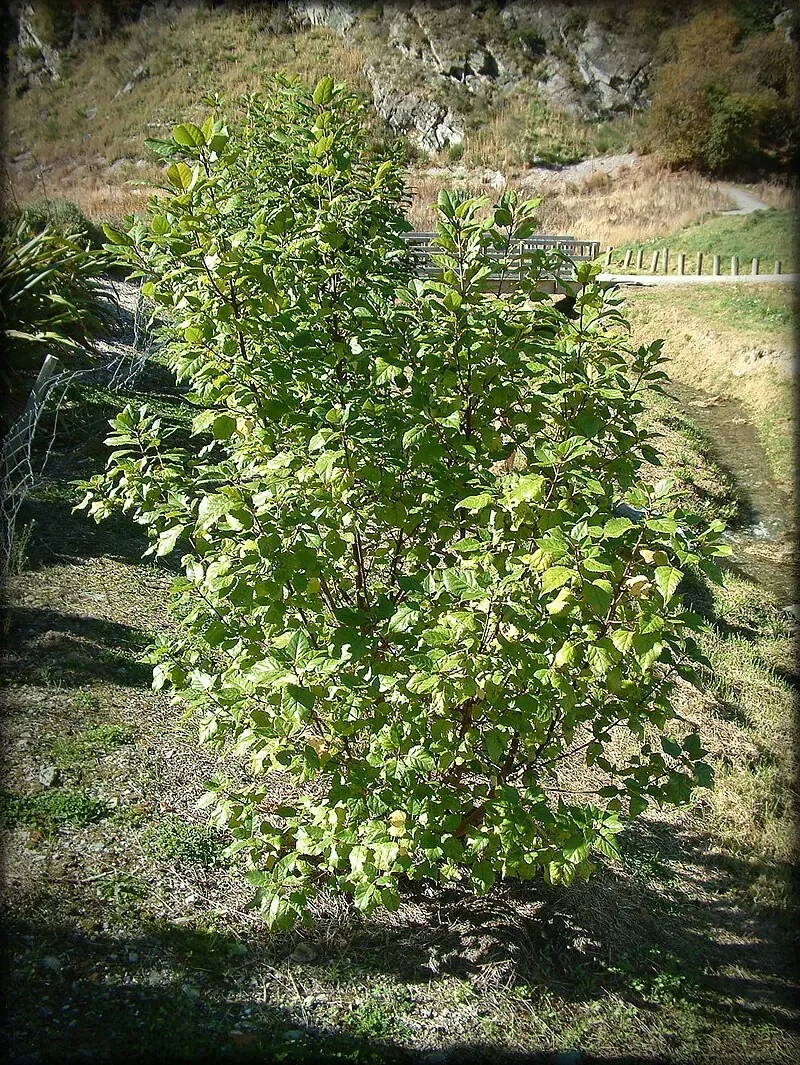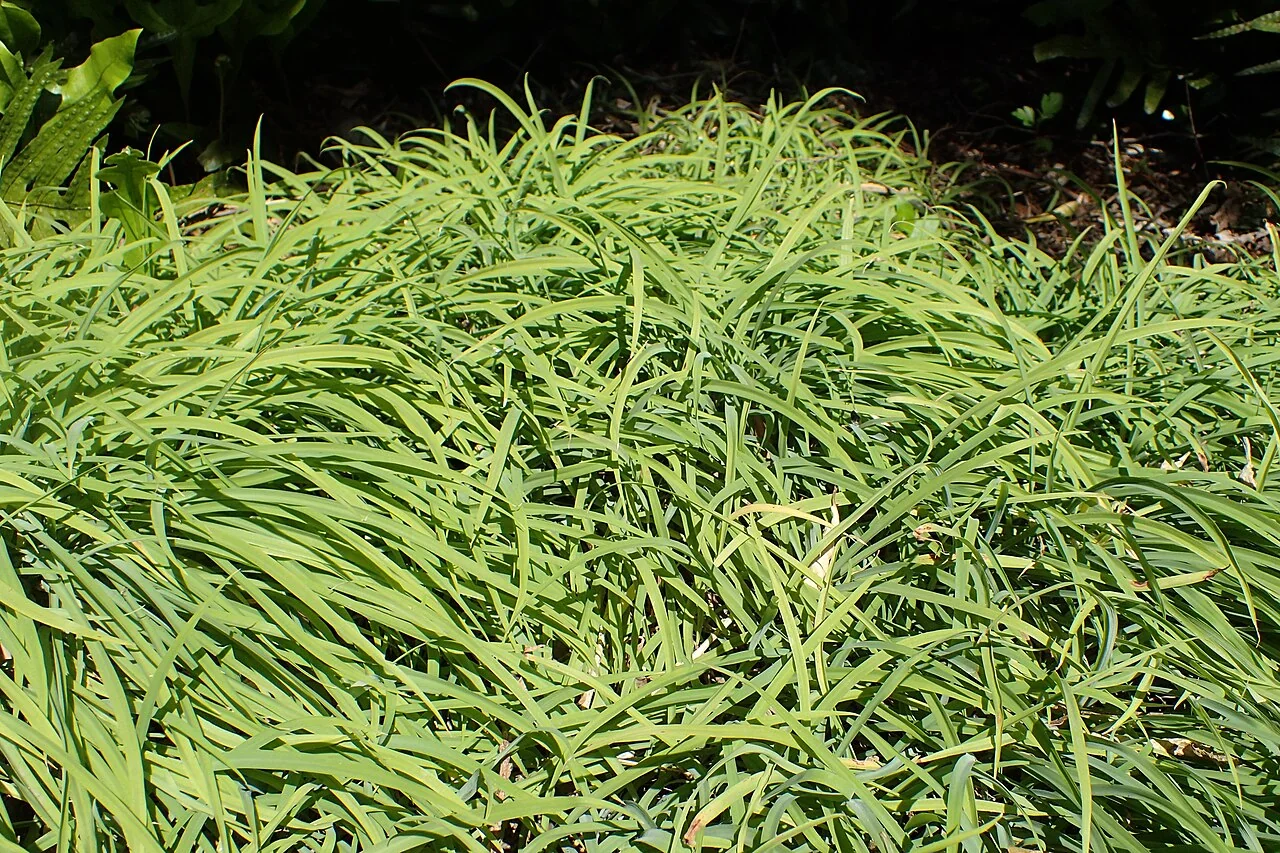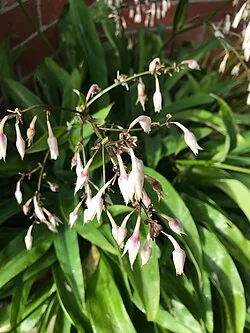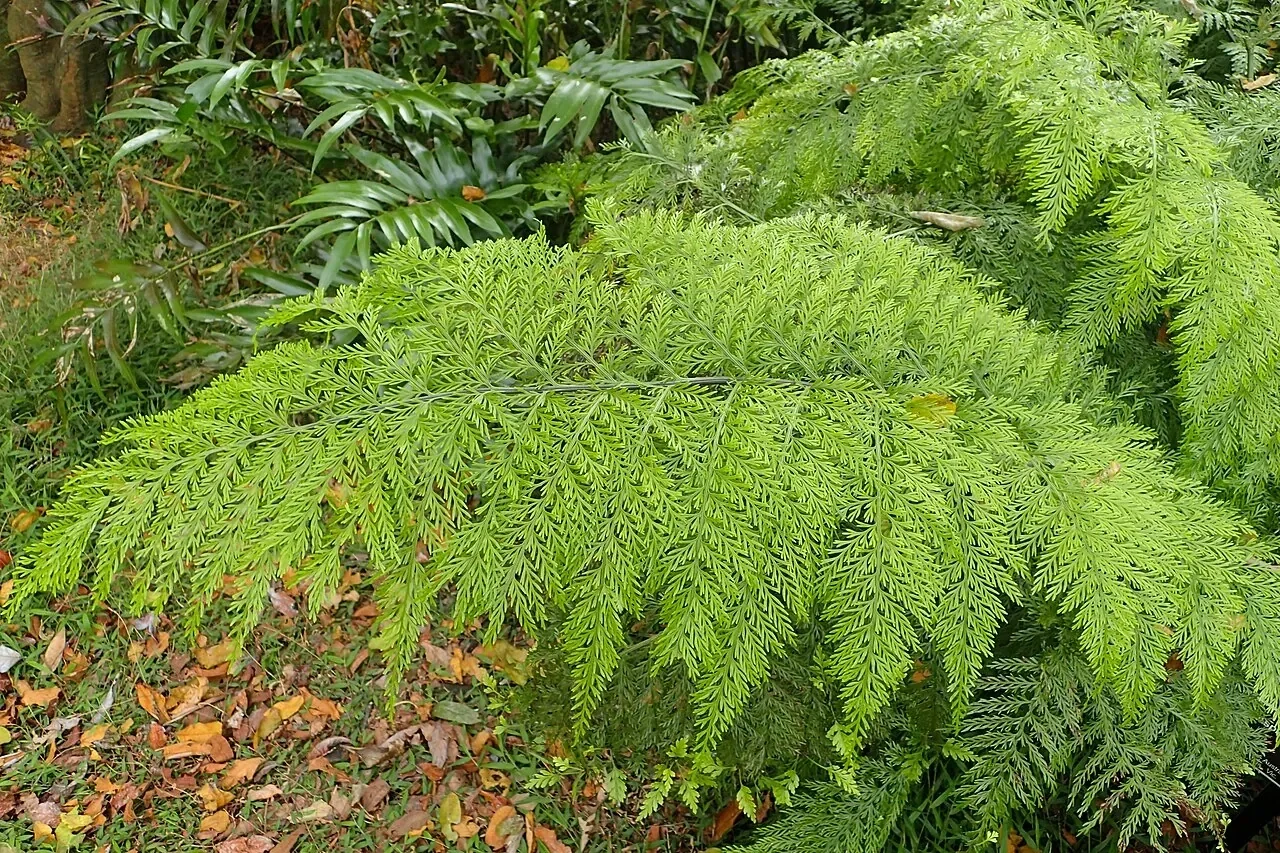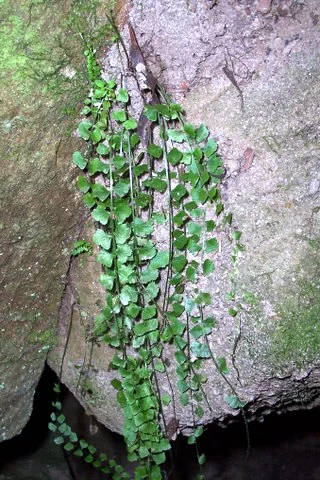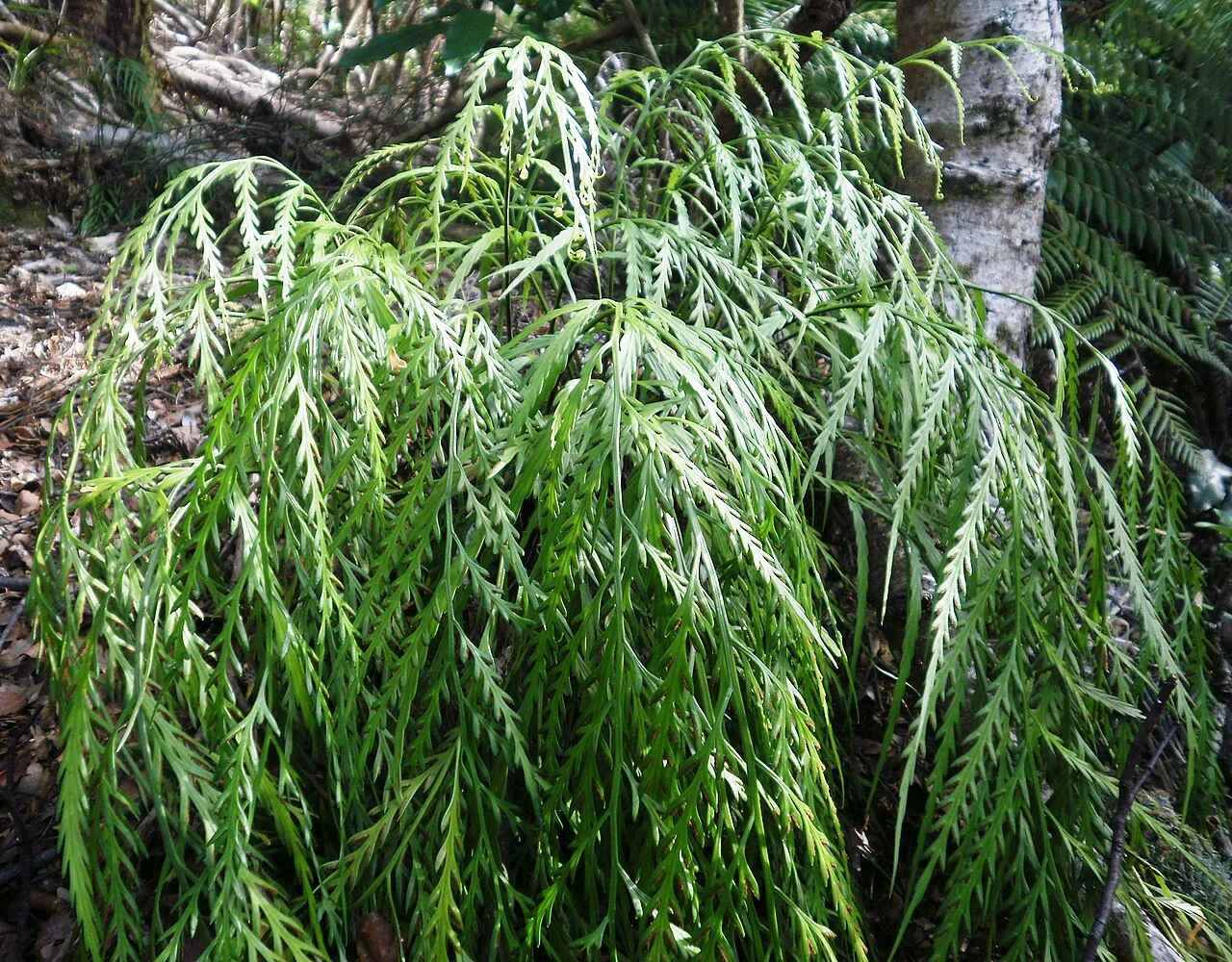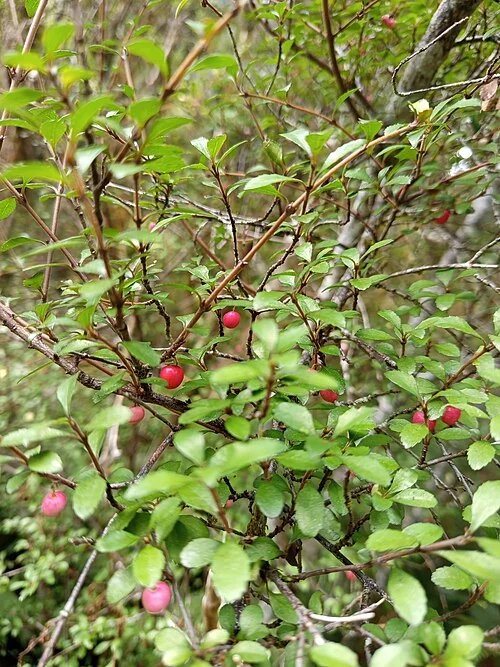
Mountain Wineberry
Aristotelia fruticosa
Mountain Wineberry ( Aristotelia fruticosa ) is a hardy endemic shrub that exemplifies New Zealand's unique divaricating plant evolution. Found predominantly in subalpine forests and shrublands throughout the country, this much-branched species grows up to 2 meters tall with distinctive small, serrated leaves and clusters of small berries that ripen from white through pink to red or black. Unlike its forest cousin Aristotelia serrata , Mountain Wineberry thrives at higher altitudes and maintains its evergreen nature year-round. The plant plays a crucial ecological role as food for native birds, particularly kererā, while also serving traditional rongoā purposes and adapting excellently to garden cultivation as an attractive native shrub .

Plant Description
Physical Characteristics
Mountain Wineberry ( Aristotelia fruticosa ) is a hardy endemic shrub that exemplifies New Zealand's unique divaricating plant evolution. Found predominantly in subalpine forests and shrublands throughout the country, this much-branched species grows up to 2 meters tall with distinctive small, serrated leaves and clusters of small berries that ripen from white through pink to red or black. Unlike its forest cousin Aristotelia serrata , Mountain Wineberry thrives at higher altitudes and maintains its evergreen nature year-round. The plant plays a crucial ecological role as food for native birds, particularly kererā, while also serving traditional rongoā purposes and adapting excellently to garden cultivation as an attractive native shrub .
Quick Facts
Overview
| Scientific Name | Aristotelia fruticosa |
|---|---|
| Height | 1-2 m (occasionally up to 9 m as tree form) |
| Spread | 1-2 m |
| Water Needs | Moderate |
| Light | Full sun to partial shade |
| Frost Tolerance | Hardy when mature (young plants frost tender) |
| Salt Tolerance | Moderate |
| Growth Rate | Fast |
| Lifespan | Long |
Climate Best Suited to
Mountain Wineberry (Aristotelia fruticosa) is naturally distributed throughout New Zealand, predominantly at higher altitudes in subalpine forests and shrublands. This hardy species demonstrates excellent cold tolerance once established, thriving in alpine to inland regions where strong frosts are common. It shows remarkable adaptability to various climatic conditions while preferring cooler, higher altitude environments.
Regional Suitability
| City | Climate Suitability |
|---|---|
| Whangārei | Ideal |
| Auckland | Ideal |
| Hamilton | Ideal |
| Tauranga | Ideal |
| Rotorua | Ideal |
| Gisborne | Ideal |
| New Plymouth | Ideal |
| Napier | Ideal |
| Whanganui | Ideal |
| Palmerston North | Ideal |
| Wellington | Ideal |
| Nelson | Ideal |
| Christchurch | Ideal |
| Dunedin | Ideal |
| Invercargill | Ideal |
Plant Habitat
Understanding Mountain Wineberry's natural habitat provides valuable insights for successful cultivation and conservation.
Natural Habitat
- Endemic to New Zealand, found throughout both main islands
- Primarily occurs at higher altitudes in sub-alpine zones
- Natural habitat: forest margins, shrublands, and disturbed areas
- Elevation range: typically 300-1200 m above sea level
- Associates with mountain beech, broadleaf, and fuchsia forests
- Common in areas with reliable rainfall and cool temperatures
Habitat Characteristics
- Prefers well-drained slopes and forest edges
- Tolerates exposed conditions once established
- Grows on various soil types from clay to sandy loams
- Found in areas with winter snow and frost
- Thrives in cool, moist conditions with good air circulation
- Often colonizes landslips and disturbed forest openings
Plant Conservation
Threats and Efforts
Mountain Wineberry (Aristotelia fruticosa) is currently classified as "Not Threatened" nationally in New Zealand, reflecting its widespread distribution and adaptability across various habitats, particularly in subalpine regions. Despite this secure national status, local populations can face pressures from habitat modification and browsing by introduced animals.
Conservation efforts for Aristotelia fruticosa are generally focused on maintaining healthy native ecosystems where it naturally occurs. This includes managing introduced pests like deer and goats, which can browse on native vegetation, and protecting its habitat from excessive disturbance. Its role as a food source for native birds also indirectly contributes to its conservation, as efforts to protect bird populations benefit the plants they feed on. While not a species of immediate conservation concern, ongoing monitoring of its populations and habitat health is important to ensure its continued resilience within New Zealand's unique flora.
Growing Requirements
Soil Requirements
Mountain Wineberry (Aristotelia fruticosa) demonstrates exceptional soil adaptability, tolerating a wide range of soil types and conditions. It naturally grows in various habitats from bush margins to stream sides, indicating flexibility in drainage and soil composition.
- Tolerates wide range of soils and site conditions
- Grows well in both well-drained and moderately moist soils
- Adapts to various soil pH levels
- Thrives in bush margins and alongside streams and rivers
- Benefits from organic matter incorporation for optimal growth
Light Requirements
Mountain Wineberry (Aristotelia fruticosa) adapts well to various light conditions, naturally growing in both forest margins and more open subalpine environments. It performs best with good light exposure but tolerates partial shade.
- Full sun to partial shade, very adaptable
- Naturally grows in bush margins with variable light
- Good light exposure promotes better flowering and fruiting
- Tolerates dappled shade under taller trees
Water Requirements
Once established, Mountain Wineberry (Aristotelia fruticosa) has moderate water requirements and good drought tolerance. Its natural habitat along streams and in subalpine areas indicates preference for consistent but not excessive moisture.
- Moderate water requirements once established
- Regular watering beneficial during establishment period
- Drought tolerant when mature
- Naturally grows alongside streams indicating moisture preference
- Avoid waterlogged conditions
Planting Guide
When to Plant
The best time to plant Mountain Wineberry (Aristotelia fruticosa) is during autumn or spring when temperatures are moderate and rainfall is more reliable. This timing allows for strong root establishment before extreme weather conditions.
Site Selection
Choose a site with:
- Full sun to partial shade with good light exposure
- Wide range of soil types - very adaptable
- Good drainage while retaining some moisture
- Space for mature spread of 1-2 meters
- Consider proximity to other plants for cross-pollination
Planting Procedure
- Dig hole twice as wide as root ball and same depth
- Improve soil with compost for optimal establishment
- Position plant at same depth as it was in container
- Backfill with improved soil, firming gently around roots
- Water thoroughly to settle soil and eliminate air pockets
- Apply 7-10cm organic mulch, keeping away from stem
- Water regularly during first growing season
Initial Care
Young plants can be frost tender and may benefit from protection during their first winter in colder regions. Once established, Mountain Wineberry becomes very hardy and requires minimal ongoing care.
Ecological Section
Mountain Wineberry plays a vital ecological role in New Zealand's high-country ecosystems and provides significant wildlife habitat and food resources.
Wildlife Support
- Produces masses of small berries highly attractive to native birds
- Important food source for bellbirds, tāā, silvereyes, and other native species
- Dense divaricating structure provides nesting sites and shelter
- Flowers attract native bees and beneficial insects
- Seeds dispersed by birds aid in natural forest regeneration
Ecosystem Functions
- Acts as nurse plant for forest regeneration on disturbed sites
- Helps stabilize soil on slopes and erosion-prone areas
- Forms natural hybrids (A. x fruserrata) increasing genetic diversity
- Supports complex food webs in sub-alpine shrubland communities
- Indicates healthy high-country forest margin ecosystems
Uses and Significance
Garden Uses
- Excellent fast-growing shrub for structural plantings
- Ideal for native garden restoration and revegetation projects
- Makes attractive hedge with regular trimming
- Outstanding for wildlife habitat and bird food provision
- Suitable for alpine and inland garden conditions
- Semi-deciduous in cooler climates, evergreen in warmer areas
Landscaping Section
Mountain Wineberry offers unique landscaping opportunities, particularly in cooler climate gardens and higher altitude properties.
Garden Applications
- Excellent specimen plant for native gardens
- Perfect for wildlife-friendly landscapes - attracts native birds
- Suitable for restoration plantings and revegetation projects
- Ideal for creating natural hedges and screening
- Works well in mixed native shrub borders
- Good choice for erosion control on slopes
Design Considerations
- Divaricating form creates interesting winter structure
- Seasonal berry display adds autumn color and wildlife activity
- Compact size (2 m) suits smaller garden spaces
- Pairs well with other high-country natives like mountain flax
- Best positioned where berry-eating birds can be observed
- Consider natural hybrid potential when planting with A. serrata
Seasonal Care Calendar
Spring
Spring is an active growing period for Mountain Wineberry (Aristotelia fruticosa). New growth appears and the plant prepares for its flowering display, making it an ideal time for planting and propagation activities.
- Active growth resumes with warmer temperatures
- Ideal time for planting new specimens
- Begin regular watering schedule for young plants
- Apply organic mulch around the base
- Good time for taking cuttings for propagation
Summer
Summer brings the main flowering period for Mountain Wineberry (Aristotelia fruticosa), with flushes of small white to pink flowers from October to December that gradually darken with age.
- Peak flowering period from October to December
- Flowers open pale and darken to pink or red with age
- Ensure adequate water during hot, dry periods
- Monitor for berry development following successful pollination
- Light pruning after flowering if shape maintenance needed
Autumn
During autumn, Mountain Wineberry (Aristotelia fruticosa) develops its distinctive berries that ripen through various colors from white and pink to bright red or black, providing important food for native birds.
- Berries ripen from white through pink to red or black
- Peak bird activity as they feast on ripe berries
- Collect fresh seed from ripe berries for propagation
- Reduce watering frequency as growth slows
- Good time for structural pruning if required
Winter
Winter is generally a quiet period for Mountain Wineberry (Aristotelia fruticosa). The plant's hardy nature means it requires minimal winter care, though young plants may need frost protection in the coldest regions.
- Growth slows significantly in colder months
- Evergreen nature maintained in most climates
- May be semi-deciduous in coldest areas
- Protect young plants from severe frosts
- Minimal watering required during dormancy
When to Prune and How Much
Timing and Technique
Mountain Wineberry (Aristotelia fruticosa) responds well to pruning and can be maintained as a compact hedge or allowed to grow into its natural divaricating form. Its fast growth rate means regular light trimming keeps it at desired size and density.
- Light pruning after flowering maintains compact shape
- Can be heavily pruned to form hedges
- Remove dead, damaged, or crossing branches at any time
- Winter pruning suits major structural work
- Regular trimming encourages dense, bushy growth
- Allow natural divaricating form for wildlife habitat
The plant's vigorous growth means it tolerates hard pruning well, making it suitable for formal hedging or renovation pruning of older specimens that may have become leggy or overgrown.
How to Grow Mountain Wineberry
Seeds
Seed propagation is the most natural and reliable method for growing Mountain Wineberry, with fresh seeds from ripe berries providing excellent germination rates when handled properly. The plant produces abundant berries from November to April, which change color from white through bright pink to dark red or black when fully ripe. For best results, collect berries when they are dark red to black, as these contain the most mature and viable seeds. Extract seeds immediately by removing all flesh and pulp thoroughly, as any remaining fruit material can inhibit germination or promote fungal growth. Fresh seeds should be sown immediately upon collection, as viability decreases rapidly with storage. Use a well-draining seed-raising mix in shallow trays or seed pots, ensuring the growing medium is sterile to prevent damping-off diseases. Sow seeds on the surface and cover lightly with a thin layer of fine sand or vermiculite, no more than 1-2mm deep, as Mountain Wineberry seeds require some light for optimal germination. Maintain consistently moist but not waterlogged conditions at temperatures between 15-20°C, which mimics the plant's natural germination conditions in spring. Germination typically occurs within 3-6 weeks under suitable conditions, though some seeds may take up to 8 weeks to emerge. Once seedlings develop their first true leaves and reach 5-10cm in height, they can be carefully transplanted into individual containers with a quality potting mix. Young seedlings grow rapidly and should be ready for planting out after one growing season when they have developed a strong root system and reached 20-30cm in height.
Cuttings
Semi-hardwood cutting propagation offers a reliable method for producing Mountain Wineberry plants that are genetically identical to the parent plant, making it valuable for maintaining specific characteristics or when seeds are not available. The optimal timing for taking cuttings is late spring to early summer when new growth has begun to firm up but is not yet fully hardened. Select healthy, non-flowering shoots from the current season's growth, choosing material that is approximately pencil thickness and shows no signs of pest damage or disease. Cut 10-15cm lengths just below a node using sharp, sterile secateurs to prevent tissue damage and disease transmission. Remove the lower leaves while retaining 2-3 pairs at the tip to reduce water loss while maintaining photosynthetic capability. Treat the cut end with a rooting hormone containing both auxins and fungicides to improve success rates and prevent root rot. Insert cuttings into a well-draining propagation mix composed of equal parts peat moss and perlite, ensuring at least two nodes are buried below the surface. Place in a humid environment with bottom heat maintained at 18-22°C and provide bright, indirect light to encourage root development without causing heat stress. Maintain high humidity through misting systems or clear plastic covers, ensuring adequate ventilation to prevent fungal problems. Rooting typically occurs within 6-10 weeks, though some cuttings may take longer depending on environmental conditions and cutting quality. Once roots are well-developed, gradually acclimatize plants to ambient conditions over several weeks before transplanting to individual containers. This method is particularly useful for commercial propagation or when specific plant characteristics need to be preserved exactly.
Natural Layering
Natural layering takes advantage of Mountain Wineberry's tendency to produce adventitious roots when branches come into contact with suitable growing medium, making it an excellent low-maintenance propagation method for home gardeners. This technique works particularly well due to the plant's naturally arching growth habit and flexible branches that can be easily manipulated to ground level. In spring or early summer when the plant is actively growing, select a healthy, flexible branch that can be bent to reach the ground without breaking. Choose a section approximately 30-40cm from the branch tip and gently wound the bark by making a shallow scratch or removing a small ring of bark to encourage root formation at the contact point. Pin the wounded section to the ground using wire pegs, small stones, or purpose-made layering pins, ensuring good contact with moist, humus-rich soil while leaving the growing tip exposed and supported upright. Cover the layered section with a mixture of compost and native soil, maintaining consistent moisture throughout the rooting period without creating waterlogged conditions. Root development typically occurs within 6-12 months, though some layers may establish more quickly in optimal conditions. Check for root development by gently excavating around the layered section after several months, looking for white, healthy root growth. Once a strong root system has developed, carefully sever the new plant from the parent using sharp secateurs, ensuring minimal disturbance to the newly formed roots. Transplant during mild weather conditions, providing shelter and consistent moisture during the establishment period. This method produces robust plants with established root systems and often has higher survival rates than other propagation techniques, making it ideal for gardeners seeking reliable results with minimal technical requirements.
Pests and Diseases
Mountain Wineberry (Aristotelia fruticosa) is generally a robust and healthy plant with few serious pest or disease problems. Its hardy nature and fast growth help it recover quickly from minor issues.
Common Issues
- Frost Damage: Young plants can be damaged by severe frosts; provide protection in first few winters
- Scale Insects: Occasionally affected by scale insects; treat with horticultural oil if severe
- Aphids: May attract aphids on new growth; usually controlled by beneficial insects
Environmental Stressors
- Drought Stress: Shows stress through reduced flowering and fruiting in very dry conditions
- Waterlogging: Poor drainage can cause root problems; ensure adequate drainage
- Wind Damage: Strong winds can damage branches in exposed sites
Prevention and Management
- Good Site Selection: Plant in appropriate conditions to minimize stress
- Adequate Spacing: Good air circulation helps prevent fungal issues
- Organic Methods: Encourage beneficial insects that control pest problems naturally
- Proper Watering: Consistent moisture without waterlogging prevents most root issues
The plant's natural hardiness and fast growth rate mean that most specimens recover quickly from minor pest or disease problems without intervention, making it an excellent low-maintenance choice for gardens.
Cultural Significance
Mountain Wineberry (Aristotelia fruticosa) was used in traditional Māori medicine (rongoā) for various purposes. The berries were also a food source, and the plant's presence in the landscape was noted for its seasonal indicators.
Bonus Tip
Attracting Native Birds to Your Garden
If you're looking to attract native birds like the kererā (New Zealand pigeon), tāā, and bellbird to your garden, planting Aristotelia fruticosa is an excellent choice. Its abundant, colorful berries are a highly favored food source for these birds, particularly in autumn and winter when other food sources may be scarce.
To maximize its bird-attracting potential, consider planting Mountain Wineberry in groups or as part of a mixed native planting that provides a continuous supply of berries throughout the year. Ensure there are also taller trees or shrubs nearby to offer shelter and perching spots for the birds. By providing both food and habitat, you can create a vibrant and lively native bird sanctuary in your own backyard.
